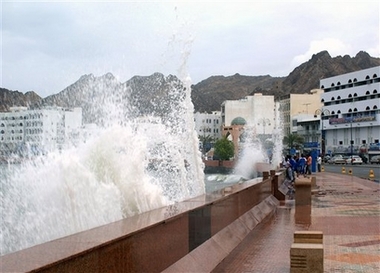Middle East
Cyclone Gonu's winds blast Oman coast
(AP)
Updated: 2007-06-06 10:49
 |
Large Medium Small |
MUSCAT, Oman - Thousands of people fled low-lying areas as the strongest cyclone to threaten the Arabian Peninsula in 60 years blasted Oman's eastern coast early Wednesday with strong winds and waves, Civil Defense officials said. Southern Iran and the oil-rich Persian Gulf were next in its path.
 Stronger than normal waves come ashore at Muscat, Oman, Tuesday June 5 2007. [AP]  |
Cyclone Gonu had weakened somewhat during the day but was still packing winds of up to 106 mph and churning up ocean waves of several feet, the officials said.
Gonu was expected to skirt the region's biggest oil installations but could disrupt shipping in the Straits of Hormuz, causing a spike in prices, oil analysts said.
Oil prices rose on Monday but retreated Tuesday, although the storm weighed heavily on the market.
"If the storm hits Iran, it's a much bigger story than Oman, given how much bigger an oil producer Iran is," said Antoine Haff of FIMAT USA, a brokerage unit of Societe Generale. "At a minimum, it's likely to affect tanker traffic and to shut down some Omani oil production as a precautionary measure."
Gonu, which means a bag made of palm leaves in the language of the Maldives, is expected to hit the east coast of Oman and head to the Gulf of Oman, according to AccuWeather.com meteorologist Donn Washburn. The cyclone was expected to hit land in southeastern Iran late Wednesday or early Thursday, Washburn said.
The Joint Typhoon Warning Center, a US military task force that tracks storms in the Pacific and Indian oceans, predicted rough seas in the Straits of Hormuz, the transport route for two-fifths of the world's oil and the southern entrance to the Gulf.
The center predicted Gonu would churn up waves of up to 36 feet.
In Tehran, the government's Department of Meteorology predicted heavy rain and strong winds along Iran's southeastern coast. Storm warnings had been issued and some damage was expected, the department said.
On Tuesday, as the cyclone approached, authorities evacuated nearly 7,000 people from Masirah, a lowland island off the east coast of Oman, according to Gen. Malik bin Suleiman al-Muamri, head of the country's civil defense. Oman's main international airport in Muscat was also closed.
Masirah Island includes one of four air bases that the Omani government allows the US military to use for refueling, logistics and storage, although little has been revealed publicly about US-Oman military ties.
The Masirah base hosted US B-1B bombers, C-130 transports and US Special Forces AC-130 gunships during the war in Afghanistan, and the United States has continued to have basing rights on the island.
US forces are preparing for Gonu "just like anyone would prepare for such a cyclone," said Lt. Denise Garcia, a spokeswoman for US Naval Forces Central Command, which is based in Bahrain. She declined to provide more details.
| 分享按钮 |